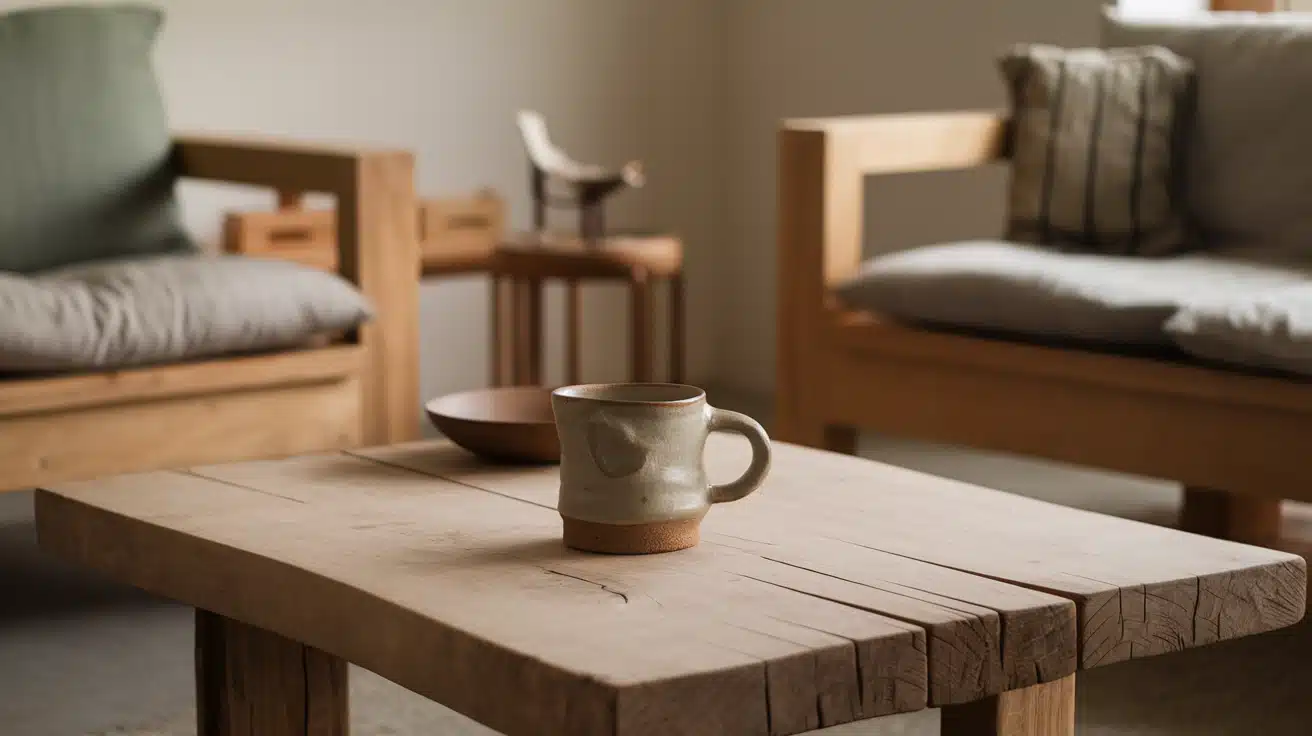What if the chips, cracks, and worn edges in your home weren’t flaws but the very things that make it beautiful? Wabi Sabi minimalism turns our obsession with perfection upside down.
In our world of polished Instagram feeds and flawless design, this Japanese philosophy offers a refreshing perspective by celebrating what’s worn, aged, and imperfect.
Wabi Sabi minimalism combines two powerful ideas: the Japanese concept of finding beauty in imperfection and the Western practice of living with less. Together, they create spaces that feel both peaceful and authentic.
This approach doesn’t just change how your home looks—it shifts how you think. By embracing natural aging and imperfection, you can create living spaces that feel more personal and live a life that values what’s real over what’s perfect.
Let’s find how this blend of Eastern wisdom and simple living can convert your space and mindset.
Understanding Wabi Sabi Minimalism
What is Minimalism?
Minimalism started in the West during the mid-20th century. It grew from art movements like De Stijl in the Netherlands and was shaped by the clean designs of the Bauhaus school. These designers looked at Japanese Zen spaces and thought, “We need more of that simplicity.”
At its heart, minimalism is about clearing away the extra stuff. It values clean spaces, simple designs, and things that work well. Think blank walls, straight lines, and neutral colors like white, black, and gray.
- Look and feel: Clean lines, open spaces, neutral colors, uncluttered surfaces.
- Goal: Creating calm through simplicity and removing excess
What is Wabi Sabi?
Wabi Sabi comes from Japan and is deeply connected to Zen Buddhism. It really took shape during the Muromachi period (1336-1573) as part of the Higashiyama culture.
Where minimalism seeks perfection, Wabi Sabi embraces imperfection. It sees beauty in things that are aging, changing, or slightly off-balance. It values handmade items with small flaws over machine-made perfect ones.
- Look and feel: Natural materials, asymmetry, patina, weathered surfaces, earthy tones.
- Goal: Finding beauty in the imperfect, incomplete, and aging
Wabi Sabi Minimalism – A Harmonious Fusion
These two approaches might seem opposite at first – one values perfect order while the other celebrates imperfection. But they share a love for simplicity that makes them natural partners.
When combined, they create spaces that feel both peaceful and real. You get the calm, uncluttered feeling of minimalism but with the warmth and character of Wabi Sabi. Your home becomes both restful and rich with meaning.
For example, a Wabi Sabi minimalist living room might have clean lines and open space but feature a handcrafted wooden coffee table with visible grain and knots. The walls might be a simple white but adorned with just one or two items that tell a story or show signs of age.
This blend gives you the best of both worlds—the breathing room of minimalism with the soul and character of Wabi Sabi. Its design feels both modern and timeless.
Core Principles of Wabi Sabi Minimalism
1. Appreciation of Natural Aging and Patina- Worn wood, faded fabrics, and cracked ceramics aren’t flaws—they’re visual stories. These signs of age bring warmth, history, and depth to a space.
2. Finding Beauty in Asymmetry and Irregularity- Perfect symmetry can feel lifeless. Handmade, uneven objects—like a wobbly mug or a raw-edge stool—add personality and authenticity.
3. Embracing Simplicity Without Stark Emptiness- Wabi Sabi minimalism values calm and simplicity, but not coldness. It’s about creating quiet, meaningful spaces that still feel lived-in and warm.
4. Focus on Authenticity Over Manufactured Perfection- Mass-produced perfection lacks soul. Handmade and imperfect items—like a woven basket or a carved spoon—bring real character to your home.
5. Connection to Natural Materials and Processes- Use materials like wood, clay, linen, and stone. These age beautifully and keep your space grounded in the natural world.
Bring Wabi-Sabi Minimalism Into Your Home
1. Materials With Soul
Bring Wabi-Sabi minimalism home through materials that feel alive. Opt for solid woods that show their grain patterns, ceramics with slight variations in glaze, natural stone with visible texture, and textiles like linen or cotton that wrinkle and soften with use. These materials age gracefully rather than just wearing out, gaining character over time.
2. Earth-Inspired Color Palette
Paint your space with colors drawn from nature. Think clay browns, forest greens, slate grays, and sandy beiges. These muted, earthy tones create a calming backdrop that feels grounded rather than trendy. Avoid bright, perfect colors in favor of subtle hues that look like they’ve been gently touched by time.
3. Thoughtfully Chosen Furniture & Objects
Select pieces with stories to tell. A bench made from reclaimed wood, a slightly irregular handmade bowl, or a vintage chair with visible repairs all bring authenticity to your space. Each item should earn its place through both function and meaning—not just as decoration.
4. Balanced Spaces
Create rooms that breathe by balancing empty space (Ma) with carefully selected items. A wall with just one meaningful piece of art can feel more impactful than a cluttered gallery. Leave room for the eye to rest and for people to move freely, but include enough warmth and texture to feel lived-in.
5. Gentle Lighting
Light your space the way nature would. Favor soft, layered lighting over harsh overhead fixtures. Think candles, paper lanterns, or lamps with warm bulbs that cast a gentle glow. Good lighting should create an atmosphere, highlighting the natural textures and shadows that give Wabi Sabi spaces their depth.
Wabi Sabi vs. Traditional Minimalism
| Aspect | Wabi Sabi | Traditional Minimalism |
|---|---|---|
| Core Philosophy | Celebrates imperfection, impermanence, and natural aging | Seeks perfection through order, clarity, and precision |
| Aesthetic | Organic textures, asymmetry, earthy tones | Clean lines, symmetry, neutral or monochrome palettes |
| Materials | Natural, weathered, handcrafted (wood, clay, stone) | Sleek, modern, often industrial or polished |
| Mindset | Embraces the beauty of flaws and time-worn objects | Removes flaws and clutter to achieve clarity and control |
| Emotional Tone | Warm, grounded, nostalgic | Cool, calm, intentional |
| Consumption | Mindful curation of meaningful, aged pieces | Minimal ownership focused on functionality |
How Wabi Sabi Minimalism Enhances Life and Well-Being
Peace of Mind
Embracing Wabi Sabi minimalism can actually reduce anxiety. When you stop chasing perfect spaces and flawless possessions, you free yourself from an impossible standard.
There’s a genuine relief in knowing that the water ring on your wooden table or the tiny chip on your favorite mug doesn’t mean you’ve failed—it means your home is real and lived in.
Kinder to the Planet
Living with a Wabi Sabi mindset naturally leads to more sustainable choices. When you appreciate how things age and develop character, you’re less likely to replace them the minute they show wear.
This means fewer items in landfills and less demand for new production. Repairing, maintaining, and loving your imperfect possessions is one of the greenest choices you can make.
Friendlier to Your Wallet
While quality items might cost more upfront, this approach saves money in the long run. By purchasing fewer, better things and appreciating them as they age, you step off the consumption treadmill.
You’ll find yourself browsing stores less often and feeling less tempted by trends or sales.
Conclusion
As we wrap up our expedition into Wabi Sabi minimalism, remember that this isn’t just about decorating—it’s about changing how you see the world around you.
By blending minimalism’s thoughtful simplicity with Wabi Sabi’s celebration of imperfection, you create more than just a beautiful space. You build a home that tells your unique story and a mindset that finds joy in life’s natural rhythms.
Start small—maybe with a handcrafted mug or by letting that wooden table age naturally instead of refinishing it. Notice how these imperfect elements make your space feel more alive and personal.
In a world constantly pushing for perfection, embracing Wabi Sabi minimalism might be the most refreshing choice you can make. After all, it’s our quirks and wear marks that make both homes and people worth knowing.
















One Comment
вавада зеркало: вавада – vavada вход